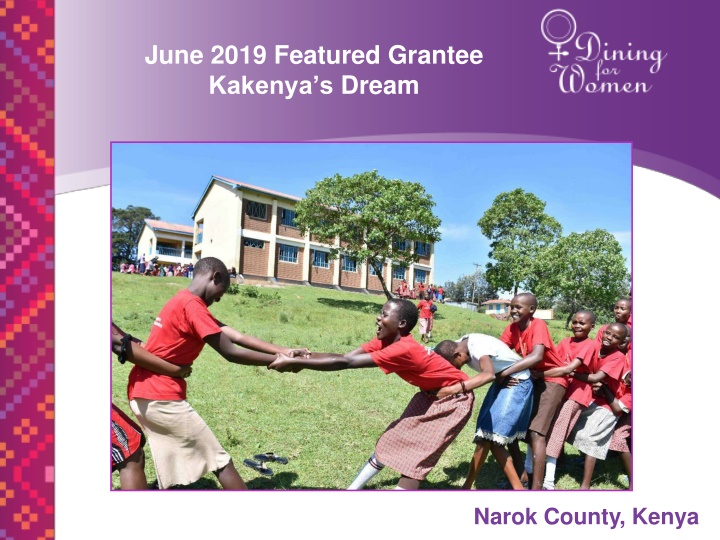
Empowering Girls through Education in Kenya: The Story of Kakenya's Dream
Discover the inspiring work of Kakenya's Dream in Narok County, Kenya, as they empower girls and transform rural communities through education. Learn about their founder, Dr. Kakenya Ntaiya, and the impactful programs they offer. Despite challenges such as FGM/C and early forced marriage, Kakenya's Dream is dedicated to ensuring every girl has the opportunity to dream, learn, and succeed. Join the movement to support girls' education and break societal barriers.
Download Presentation

Please find below an Image/Link to download the presentation.
The content on the website is provided AS IS for your information and personal use only. It may not be sold, licensed, or shared on other websites without obtaining consent from the author. If you encounter any issues during the download, it is possible that the publisher has removed the file from their server.
You are allowed to download the files provided on this website for personal or commercial use, subject to the condition that they are used lawfully. All files are the property of their respective owners.
The content on the website is provided AS IS for your information and personal use only. It may not be sold, licensed, or shared on other websites without obtaining consent from the author.
E N D
Presentation Transcript
June 2019 Featured Grantee Kakenya s Dream Narok County, Kenya
Introducing Kakenyas Dream HEADLINE GOES HERE Text goes here Text goes here Text goes here Text goes here Kakenya s Dream leverages education to empower girls and transform rural communities. They believe every girl, no matter where she is born, deserves a chance to dream, learn, and achieve her full potential.
About the Featured Grantee Founded in 2008 by Dr. Kakenya Ntaiya Began as a primary boarding school for girls, the Kakenya Center for Excellence, with a single class of 4th graders Now three interconnected programs, including the school, the Network for Excellence, which supports KCE alumnae HEADLINE GOES HERE through secondary school and beyond, and the Health and Leadership Training program, which reaches youth across the community with crucial information and skills training Among many honors for Kakenya: Top Ten CNN Hero, 2010 National Geographic Emerging Explorer, one of Newsweek s 150 Women Who Shake the World in 2011, Women Deliver 100: The Most Inspiring People Delivering for Girls and Women, and featured in a Washington Post series, a National Geographic feature, a BBC documentary and many magazine articles. Watch her TED talk here. Text goes here Text goes here Text goes here Text goes here
Where in the world? Kenya s population is more than 48 million More than 40% of Kenyans are under the age of 15 The literacy rate for the total population is 78%, with 81.1% males being literate and 74.9% of females Maasai girls continue to face many challenges in Kenya, particularly in remote areas, including a lack of agency within the family and community. FGM/C and early forced marriage are common. The median age in Kenya is 20 years, with a life expectancy of 64.6 years. The birthrate is 22.6 births/1,000 population Narok County, Kenya
Life Challenges of the Women Served HEADLINE GOES HERE Text goes here Text goes here Text goes here Text goes here Girls in Kenya are often viewed as economic assets to help with chores and family economic activities, and their education is not a priority. In the organization s region, over 80% of girls undergo FGM/C when they reach puberty, after which they enter into an arranged marriage, ending their education before even completing primary school. In Narok County, 40% of girls between the ages of 15 and 19 have already given birth to at least one child, more than twice the national average.
Life Challenges of the Women Served Only 17% of girls in the community attain a primary education. The challenges girls in the region face perpetuate cycles of poverty, low educational achievement, pervasiveness of HIV/AIDS, high teenage pregnancy rates, and high rates of infant and maternal mortality.
Budget DFW s grant of $45,000 for one year will be used for the following: Item Description Total Personnel Expenses Includes 30 percent of the salary for the program manager, the salary for a program officer, trainer s fees, and counselor allowances. $18,040 HEADLINE GOES HERE and Supplies speakers, accommodation for speakers, trainers and staff, honoraria for speakers, training supplies, campers gifts, and Program Services Meals for trainings, transportation for participants, staff, and $19,500 communication. Text goes here Text goes here Text goes here Text goes here Other Activities Peer to peer launch, monitoring and evaluation expenses. $7,460 TOTAL EXPENSES $45,000
What are we supporting? The goals of the program are: that more girls are aware of and can protect their rights, including bodily integrity and freedom from violence, and to see changes in social norms related to human rights of girls and young women, resulting in elimination of FGC, reduction in child marriages, and increased support for girls education. Direct Impact: 3,500; Indirect Impact: 7,000
Share Your Thoughts 1. How does this project promote self- sufficiency for women and girls? 2. How do you think the inclusion of boys in the HEADLINE GOES HERE weekend trainings helps achieve the project s goals? Text goes here Text goes here Text goes here Text goes here 3. In what way will the peer-to-peer component affect the sustainability of the project?
Junes Sustained Grantee: RIPPLE Africa Changu Changu Moto Project (Malawi) Brings the CCM cook stove to 5,743 households in Nkhotakota and HEADLINE GOES HERE Mzimba Districts of Malawi. This simple, low-tech, fuel-efficient stove is constructed from mud bricks made from locally-sourced materials that are free and readily available. Women receiving the cookstoves are also trained in its maintenance and upkeep. Since women are involved from beginning to end, it helps ensure a sense of pride and ownership of the stove and empowers them with the ability to maintain it. Direct Impact: 14,358 women and girls; Indirect Impact: 14,358 family members Text goes here Text goes here Text goes here Text goes here













